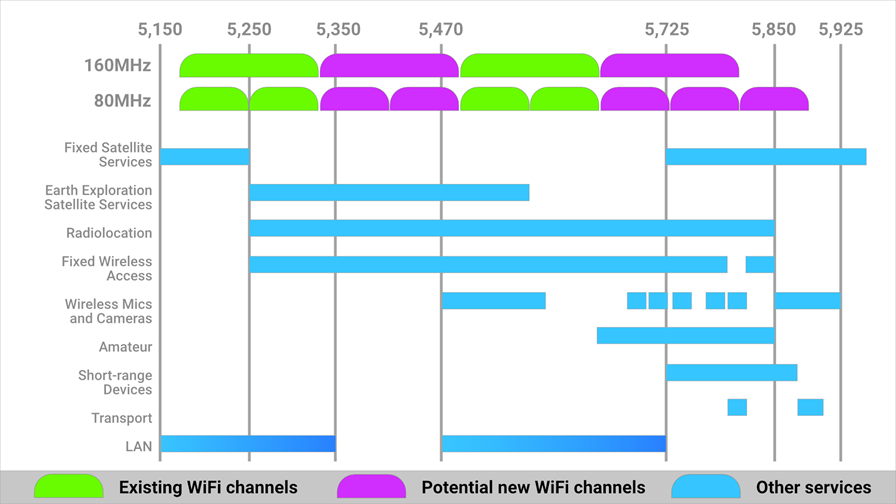
data © Ofcom / design TTV
- Ofcom plans to increase number of 5GHz channels from 4 to 6
- 5350-5470MHz and 5725-5925MHz being considered
- Consultation on coexistence issues required
- 89 per cent of all broadband connected households use WiFi
UK regulator Ofcom has today published its proposals to help speed up WiFi connections by opening up an additional ‘sub-band’ within the 5GHz frequency range for WiFi. The extra sub-band would increase the number of 80MHz channels available for WiFi from four to six. Ofcom recently revealed that WiFi is being used in over 89 per cent of all broadband connected households to extend the fixed connections to in-home devices.
The regulator believes that these extra channels – which are already being used in the US, although far from being harmonised internationally – could be opened up in the UK within a few years. This includes time to conduct a study of the technical conditions that will allow the sub-band to be used in a way that appropriately protect other users, to then consult on these conditions, take any steps required to create new standards or regulations, and to allow time for manufacturers to update their products.
Ofcom says it is keen to work with the industry to understand how an increase in the number of channels available for WiFi usage in the 5GHz range might help meet growing consumer demand – in particular, how and when additional spectrum should be made available, with safeguards to protect existing users.
“People are placing greater demands on their broadband, so we need to ensure they aren’t let down by their wireless connection,” said Philip Marnick, Group Director of Spectrum at Ofcom. “We also want to close the gap between advertised speeds and the wireless performance that people and businesses actually receive. So we’re exploring ways to open up more airwaves for Wi-Fi.”
Ofcom stated back in 2014 that the 5350 to 5470MHz and 5725 to 5925MHz bands were a high priority for development. To ensure indoor WiFi networks can support increasing superfast broadband speeds, the need for additional contiguous spectrum was identified to accommodate wider channels and prevent interference occurring between adjacent households. To help meet this demand, the potential extension of the 5GHz licence exempt band was first mooted in preparation for the ITU’s WRC-15 last November.
Coexistence and sharing
However, there are important services currently operating in the 5GHz bands in the UK, such as remote sensing services and applications in the 5350–5470 MHz band. Therefore, Ofcom is continuing to undertake detailed technical coexistence studies on this issue.
Ofcom is already committed to undertake work on spectrum sharing, as set out in its 2015 Mobile Data Strategy document. It wants to encourage wider use of spectrum sharing in the mobile broadband, WiFi and IoT sectors. As well as ensuring WiFi can continue to provide high speed wireless connectivity, it wants to understand how spectrum can be shared more effectively between different types of users through advances in dynamic spectrum access technologies – likely to be at least part of the solution to meeting the growth in demand for mobile data services.
If sharing is proven to be feasible, Ofcom believes the 5.925–6.425GHz band could be beneficial for either cellular or LAN use. The band could potentially be used for WiFi services in addition to, or as an alternative to the WiFi extension bands currently under consideration. However, this could be more applicable to cellular offload over WiFi. Ofcom estimates that offloading to WiFi and femto cells could increase from around 50 per cent of traffic today to 70-90 per cent in 2030.
Interference problems
Ofcom’s proposal contains some interesting findings from its WiFi user app. Collected data suggests that the presence of other WiFi routers nearby significantly reduces the likelihood of a mobile phone or tablet achieving 35Mbit/s via Wi-Fi. When there were no other routers detected by the mobile phone or tablet performing the test, 39 per cent of 5GHz users could achieve 35Mbit/s. If there were other routers in the vicinity, this dropped to 19 per cent. The equivalent numbers for 2.4GHz users were 14 per cent for isolated users, dropping to just 7 per cent in the presence of other routers.
Densification is another answer to increasing WiFi availability, but it is not perfect. A study by Cisco found that the inexpensive nature of basic WiFi access points made it tempting to deploy them with very high density, but it could then be necessary to reduce the transmit signal powers to prevent access points generating interference to each other. In some cases, the reduction in the transmit power exactly offset the potential benefit of interference immunity. Back to square one.
Consultation on Ofcom’s plans closes in July. Global harmonisation across the 5GHz band will not happen before 2020 at the earliest, following discussion at WRC-19. But the good news for Brexit supporters is that the UK can go ahead and open up the 5725-5850MHz band – without waiting for its European neighbours to collectively decide to do the same – as there is no legally binding EC Decision that restricts the UK from doing so.
Email Newsletters
Sign up to receive TelecomTV's top news and videos, plus exclusive subscriber-only content direct to your inbox.




